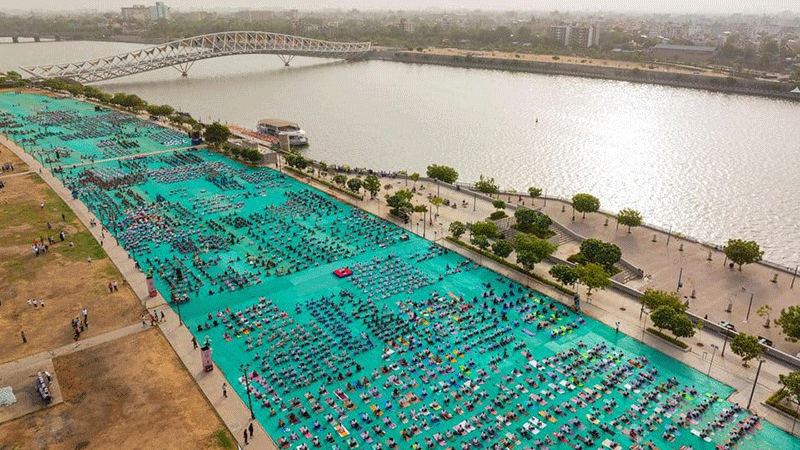 |
Thousands doing yoga together on the Sabarmati riverfront in Ahmedabad, India, on World Yoga Day, on June 21. |
Indian cities keen to develop riverfronts but bogged down by polluted rivers
NEW DELHI (The Straits Times/ANN) -- As Indian cities roll out plans to build attractive riverfronts, the improvements on land are outpacing attempts to clean up the waters of the polluted rivers below them.
In the western state of Gujarat, a plan to extend the riverfront from the existing 11.25km in Ahmedabad city along the Sabarmati River to 38km includes the development of a 17.5km stretch by Singapore firm Surbana Jurong.
The urban planning and design specialist is creating the masterplan for the last phases of the development, covering 591ha of land. The first phase was completed in 2012 but other earlier phases are in different stages of development by other companies.
“When completed, it will be the longest riverfront project in the world, with a total length of over 38km,” said Mr Abhishek Malhotra, Surbana Jurong’s regional director for South Asia.
While the riverfront projects have given residents a much-needed public space, a key challenge for Ahmedabad and other cities with riverfront plans, however, is the extremely polluted rivers, which are clogged with sewage, toxic chemicals discharged by factories and rubbish from rapidly growing cities.
Along the 371km-long Sabarmati River, which flows from the north-western state of Rajasthan into Gujarat, multiple cleaning operations have taken place but with limited success, said environmentalists.
In the latest initiative to clean up the river, some 60,000 residents of Ahmedabad have since May 15 picked up 945 tonnes of waste from the riverbed after water was drained to repair the Vasna Barrage, which controls the flow of water into the Sabarmati River near the riverfront.
This is among other initiatives, both short and long term, to clean up the river – from using trash skimmers to collect floating rubbish to tackling the problem of untreated sewage. However, the pollutants going into the river have continued to outpace clean-up efforts, noted environmentalists.
“The cleanliness drive is also to ensure wider awareness so that people don’t throw waste into the river. We want river waters to be clean,” said Ahmedabad municipal commissioner Banchhanidhi Pani.
But it is not just the discarded rubbish that is the problem.
A report released recently by Toxics Link, an Indian environmental research and advocacy organisation, said high levels of nonylphenol – a chemical with carcinogenic properties that can cause prostate cancer in men and breast cancer in women – were detected in the surface water of four rivers including the Sabarmati, downstream of the riverfront project.
The chemical, which also kills aquatic life, is used in the textile industry in particular. The report found the highest concentration of the chemical in Cooum River in Tamil Nadu.
“It is not enough to keep the riverfront water clean and not the rest of the stretch,” said Mr Mahesh Pandya, director of Paryavaran Mitra, a Gujarat-based non-governmental organisation dedicated to protecting the environment.
In September 2024, the Gujarat High Court rebuked the local authorities for failing to come up with a concrete plan for cleaning up the river. The court initiated public interest litigation on its own and has kept a close scrutiny over the clean-up efforts. “All your claims are on paper,” the court noted, according to a report in the Gujarat Samachar newspaper.
Contamination from untreated sewage is a common problem for India’s rivers.
According to some estimates, 38,000 million litres of wastewater enter Indian rivers due to the lack of functioning sewage treatment plants and poor waste disposal.
Polluted rivers present a jarring challenge to local governments’ plans to spruce up riverfronts and turn them into attractive urban community spaces. A report by the School of Planning and Architecture (SPA) said 61 riverfront projects have been initiated under the Smart Cities Mission, an urban renewal and retrofitting programme by the government to improve facilities and infrastructure in Indian cities. Many more are being developed outside the mission.
Along the Sabarmati, the first 11.25km of the riverfront development, completed in 2012, has been held up as an exemplary instance of riverfront development in India.
(Latest Update June 9, 2025)
|